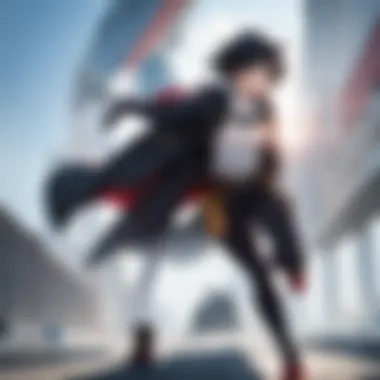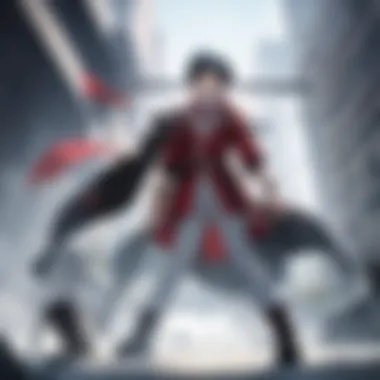Exploring My Hero Academia: The First Movie's Impact


Intro
The emergence of My Hero Academia as a prominent entity in anime and manga culture is not accidental. Its captivating storytelling and well-defined characters have won over numerous fans globally. This article delves into the first My Hero Academia movie, offering a meticulous evaluation of its role within the franchise. We will probe into character arcs, thematic elements, and overall artistic merit.
Character Profiles
Overview of Main Characters
In the first My Hero Academia movie, several key characters from the series play crucial roles. These characters are not just central to the plot, but they also embody the show's core values and themes.
Izuku Midoriya stands out as the protagonist. His journey from a quirkless boy to a budding hero serves as the emotional backbone of the story. Midoriya's determination and growth are emblematic of the narrative's central theme of seeking one's potential.
All Might acts as both a mentor and a representation of hope for Midoriya. His constant encouragement frames the movie's motivational message.
Katsuki Bakugo, while often brash, shows diverse layers of personality, especially his evolving friendship with Midoriya. This complexity contributes greatly to the film's richness.
Supporting Characters
The supporting cast also plays a vital role. Characters such as Ochaco Uraraka and Shoto Todoroki exhibit their strengths, contributing effectively to the team dynamics. Their varied abilities and contrasting approaches underscore the film’s emphasis on teamwork and personal growth. Without these characters, the narrative would lack depth.
Theme Exploration
Central Themes
The first movie explores several themes intrinsic to the My Hero Academia series. The most prominent among them is the concept of heroism. What does it truly mean to be a hero? The film challenges traditional notions by showcasing that heroism is not merely about strength but also compassion, sacrifice, and personal growth.
Moreover, the theme of friendship and collaboration shines throughout. Characters must rely on each other to overcome obstacles, reinforcing the message that success often comes through unity rather than individual effort.
Cultural References
The film adeptly integrates various cultural references, illustrating the nuances of Japanese society. Concepts such as perseverance resonate deeply within the narrative, highlighting the importance of hard work and ambition in a way that reflects broader societal values.
"In a world where quirks dominate, the film reminds viewers of the timeless struggle to define one's destiny."
Popular Series and Recommendations
This movie's success reinforces the popularity of anime among viewers. If you enjoyed this film, consider exploring other series that similarly delve into themes of heroism and personal growth.
Top Anime Series of the Year
- Jujutsu Kaisen
- Attack on Titan
- Demon Slayer
Hidden Gems in Manga
- The Promised Neverland
- Vinland Saga
- Yona of the Dawn
These recommendations cater to fans looking for rich narratives and engaging character development, akin to that found in My Hero Academia.
Prelude to My Hero Academia
The topic of My Hero Academia is integral to understanding the essence of its first movie. This article aims to dissect various facets of the series, analyzing so much more than just animation and action. It revolves predominantly around themes such as heroism, friendship, and personal growth, which resonate deeply with the audience. The significance of My Hero Academia lies not only in its compelling characters but also in the intricate world-building that creates a rich setting for the narrative.
This segment will first provide an overview of the series, establishing its foundational concepts and narrative arcs. Then, it will explore the broader idea of heroes in anime, illustrating how My Hero Academia positions itself within this popular trope. By delving into these areas, the narrative will set the stage for the analysis of the film itself, making it pertinent for both fans and newcomers alike. The exploration looks into how My Hero Academia has redefined the hero narrative and why it's influential in contemporary anime culture.


Overview of the Series
My Hero Academia first debuted in 2014 as a manga, quickly capturing attention for its relatable characters and engaging storyline. The series centers around a world where most individuals possess superpowers known as "Quirks." These abilities create a divide between normal citizens and those with powers. The main protagonist, Izuku Midoriya, is born without a Quirk but strives to become a hero. His journey underlines themes of perseverance, hard work, and destiny.
The storytelling combines traditional shonen elements with a fresh perspective on heroism. The characters’ growth and relationships drive the plot, fostering strong emotional connections. Each arc in the series builds upon the last, establishing a larger narrative framework. The interplay of personal dreams and societal expectations adds depth, making the series resonate with a diverse audience.
The Concept of Heroes in Anime
The notion of heroes has been a longstanding theme in anime, often explored through various narratives. However, My Hero Academia presents a nuanced depiction that challenges conventional understandings. It emphasizes that heroism is not merely a title; it is rooted in the spirit of altruism and sacrifice. The characters often face moral dilemmas, testing their definitions of what it truly means to be a hero.
The series introduces a variety of characters, each embodying different aspects of heroism. All Might, the Symbol of Peace, represents strength and hope but also the burden of expectations. In contrast, Bakugo, initially portrayed as antagonistic, reveals the complexity of rivalry and ambition as forms of heroism. These diverse interpretations encourage viewers to reflect on their own beliefs about heroes and what they represent in society.
Ultimately, My Hero Academia invites its audience to redefine the hero archetype while embarking on individual narratives of growth and compassion. By intertwining personal struggles with larger societal issues, it offers a fresh lens through which to view heroism in anime.
My Hero Academia Movie One: Key Details
The first movie adaptation of My Hero Academia holds significant importance within the broader context of the series. This section explores critical elements regarding its release and production background. Understanding these aspects offers insight into how the film captures the essence of the original narrative while catering to both loyal fans and newcomers alike.
Release Information
My Hero Academia: Two Heroes premiered in Japan on August 3, 2018. It was a major event for anime enthusiasts, generating considerable buzz due to the show's popularity. Following its initial release, the movie saw international distribution in various countries. Notably, the film reached North American audiences by early 2019, making it accessible to a wider fan base.
The promotional strategies prior to release involved multiple trailers and artwork showcasing key characters and the film's high-stakes plot. This generated excitement and anticipation within the community. Box office performance was impressive, with the film grossing over $15 million globally within the first month. The positive reception underscored the effectiveness of its marketing and storytelling, further solidifying My Hero Academia as a cultural phenomenon.
Production Background
The production of My Hero Academia: Two Heroes was spearheaded by Bones, a studio known for its high-quality animation and attention to detail. The director, Kenji Nagasaki, aimed to maintain the integrity of Kohei Horikoshi's original work while introducing new elements for the film. Collaborating with Horikoshi himself, the creative team ensured that the film resonated with existing fans, incorporating familiar characters and settings familiar from the series.
The film employed a talented voice cast, including familiar faces from the anime series. This continuity helped preserve the show's atmosphere, as voice actors captured the essence of their characters. The animation quality stands out, maintaining the vibrant art style that My Hero Academia is renowned for. With a budget that allowed for extensive visual endeavors, the film showcases breathtaking fight scenes and detailed character designs.
In summary, the release and production background of My Hero Academia: Two Heroes play a pivotal role in understanding its success. By connecting fan expectations with anime industry standards, the film delivers a compelling narrative that adds depth to the My Hero Academia lore.
The careful coordination between the original creator and the production team is what sets this film apart from typical adaptations.
Plot Analysis
The exploration of plot analysis is essential in understanding the first My Hero Academia movie. Plots serve as the backbone of any story, including anime films. Analyzing the plot helps to reveal character motivations, the pacing of the narrative, and the thematic depth of the work. The importance of this section lies in its ability to dissect how events unfold, and how they contribute to the overall experience of viewing the film. It allows the audience to connect emotionally with the characters and comprehend the stakes involved. By understanding the plot in detail, viewers can appreciate the underpinning narrative and thematic elements, which elevate the film beyond mere entertainment.
Synopsis
The first My Hero Academia movie follows the journey of Izuku Midoriya and his classmates as they attend a training camp. Their main goal is to prepare for a prestigious sports festival. However, their plans are disrupted by an unexpected villain threat. The plot quickly escalates as the students must combine their strengths to overcome challenges. The essence of the story lies in teamwork, growth, and the courage to face adversities. Through various obstacles, Midoriya and his peers learn more about themselves and each other, illustrating their development as both heroes and individuals.
Key Themes
Heroism
Heroism features as a fundamental aspect of the narrative, emphasizing the idea that being a hero extends beyond physical power. In this story, heroism is characterized by courage, selflessness, and the drive to protect others. The film illustrates that true heroes are those who stand against injustice, regardless of the personal cost. This idea resonates strongly with audiences, fostering inspiration and admiration for the characters. The unique aspect of heroism portrayed is that it is not an inherent trait but rather a pursuit. This concept provides powerful moral lessons, making it a beneficial focus in this analysis.
Friendship
Friendship plays a critical role, showing how bonds among characters influence their growth. The film highlights the importance of trust and support during challenging times. Friendship is depicted as a source of strength. When characters work together, their individual abilities are enhanced. This theme underscores the idea that heroes are not forged in isolation; rather, they thrive in collaboration. This feature of friendship adds a layer of depth, making it a significant choice for discussion in this article, as it shows the relatable human experience of camaraderie.
Sacrifice
Sacrifice is another key theme woven through the plot, revealing the lengths to which characters go for the sake of others. This aspect illustrates that true heroism involves making difficult choices, often at a personal cost. The film demonstrates situations where characters must weigh their desires against the needs of those around them. The unique feature of sacrifice highlighted is the emotional weight it carries. This emotional element connects deeply with the audience, offering both advantages and challenges in interpreting the story. Discussing this theme enriches the overall analysis, as it complicates the notion of what it means to be a hero and encourages viewers to reflect on the moral implications of their choices.


Character Development
Character development plays a crucial role in understanding the depth of My Hero Academia and its first movie. It is not just about the physical journey of characters but also about their emotional and psychological growth. The development of characters enhances storytelling, allowing audiences to connect on a personal level. In the context of this movie, characters undergo significant transformations that reflect broader themes of heroism, determination, and sacrifice.
Through well-crafted arcs, the characters in this film reveal their motivations and fears. This process allows viewers to see the evolution from ordinary individuals to heroes. This journey highlights the essence of what it means to be a hero, resonating with the audience and reinforcing the series' central themes.
Additionally, the interactions between characters contribute to a rich narrative tapestry. The growth and relationships among characters often shine through pivotal moments, showcasing their struggles and triumphs. This development is not just beneficial; it is essential in creating a compelling story that encourages the audience to invest emotionally.
Protagonist Analysis: Izuku Midoriya
Izuku Midoriya stands out as an exemplary protagonist in My Hero Academia. His transformation from a quirkless boy to a promising hero encapsulates the spirit of perseverance. Midoriya's character resonates with those who face challenges in pursuing their dreams. He is often depicted as determined, intelligent, and empathetic. These traits make him relatable, showcasing the potential in everyone to grow and adapt.
His journey in the first movie emphasizes his struggle to fully harness his inherited abilities. This internal conflict adds depth, making the audience root for his success. Midoriya’s character represents the fight against limitations, a sentiment that many can identify with. Consequently, he becomes a symbol of hope and resilience in a world where the stakes are high, and failure looms large.
Supporting Characters
Supporting characters play a vital role in complementing the protagonist's journey in the film.
All Might
All Might, the former number one hero, acts as a mentor to Midoriya. His role is multifaceted, providing guidance while embodying the ideal hero. What makes All Might compelling is his duality: he represents strength and vulnerability simultaneously. This aspect is integral to the story as it illustrates the cost of being a hero.
His iconic catchphrase, "I am here!", serves as a beacon of hope. This attribute adds emotional weight to the narrative. All Might’s legacy, however, is not without challenges. His struggle against injury and old age represents the transient nature of power. Understanding All Might's character enriches the discussion of heroism and transformation in the movie.
Bakugo
Bakugo's character introduces a contrasting perspective to Midoriya's path. With his explosive temperament, Bakugo challenges the status quo and represents ambition and fierce determination. His rivalry with Midoriya is a driving force in the narrative. Bakugo’s character showcases the complexity of heroism; he is not merely an antagonist but a driven individual striving for success.
His development throughout the movie emphasizes the importance of understanding and empathy among peers. Bakugo's outbursts often hide deeper issues of insecurity. By examining his character, the audience gains insights into the multifaceted nature of competition and collaboration.
Uraraka
Uraraka adds a layer of relatability and warmth to the story. She embodies kindness and steadfast support for others, particularly Midoriya. Her character highlights themes of friendship and teamwork, essential elements in the pursuit of heroism.
Uraraka's journey in the film focuses on her desire to become a hero and her motivations behind it. Her rich emotional depth makes her character much more than just a supporting role. Through her, the narrative explores the idea that heroism can take many forms, including selflessness and support for one another.
In essence, the supporting characters in the first My Hero Academia movie enrich the viewing experience. They complement Midoriya's journey through unique growth arcs, making the overarching themes more impactful.
Artistic Elements
The artistic elements of any animated feature play a crucial role in shaping the viewer's experience. In the case of My Hero Academia: The First Movie, these elements significantly contribute to the overall storytelling, emotional resonance, and engagement with the audience.
Animation Quality and Style
The animation quality in My Hero Academia: The First Movie stands out due to its vibrant visuals and dynamic movement. The character designs retain the familiar aesthetics from the series, yet they are polished to give them a cinematic flair. Fast-paced action sequences are fluidly animated, allowing viewers to fully appreciate the intensity of battles.
This attention to animation detail is not merely for style; it serves to convey the personalities and growth of the characters. For instance, Izuku Midoriya's movements reflect his struggle and determination. When he faces overwhelming odds, the animation underscores his growth from a timid boy to a resolute hero.
Overall, the animation quality not only elevates the visual experience but also plays a significant role in storytelling by visually representing character arcs and themes.
Soundtrack and Sound Design
The soundtrack in My Hero Academia: The First Movie synergizes with the animation to enhance emotional moments and amplify action scenes. Composed by Yuki Hayashi, the music transitions smoothly between intense battle scores and softer, reflective themes. This fluidity aids in guiding the audience's emotional journey throughout the film.


Moreover, sound design is equally noteworthy. The use of sound effects, from the shattering of concrete during superhero confrontations to subtle ambient sounds that ground scenes in reality, creates an immersive viewing experience. By combining both music and sound design, the filmmakers ensure that viewers feel the weight of the scene, be it during a climactic battle or a quieter moment of reflection.
"Sound and visual elements work in tandem to create a unique atmosphere that is integral to the film's narrative impact."
Audience Reception
Understanding audience reception is crucial when analyzing a film like the first My Hero Academia movie. It reflects how viewers engage with the material, capturing their emotional responses and critical interpretations. This feedback from the audience can significantly influence the film's legacy and its place within the broader narrative of the franchise.
Box Office Performance
The box office performance serves as a key metric for the film's success. My Hero Academia: Two Heroes was well-received, grossing over 3.2 million dollars in its opening weekend in the United States. This performance indicated not only a strong fanbase but also the growing popularity of anime in Western markets. The financial success is often attributed to the loyal following of the My Hero Academia series. Its established viewer base contributed positively to ticket sales.
In terms of overseas success, the movie performed admirably in Japan too, underscoring the series's cross-cultural appeal. Many fans chose to watch the film multiple times, which is common for beloved franchises. Additionally, the release saw promotional events that further boosted interest and attendance.
Critical Reviews
Critical reception plays another significant role in shaping the film's identity. Critics have pointed out various strengths and weaknesses of the movie. Many have praised the animation quality, highlighting its fluidity and attention to detail. The action sequences were often noted as standout moments, showcasing the studio's capabilities in delivering high-octane scenes.
On the other hand, some reviews were mixed, particularly with the depth of storyline and character development. Critics mentioned that while the animation and action were commendable, the plot occasionally felt thin. It struggled at times to match the narrative complexity of the series.
"The visual storytelling of My Hero Academia: Two Heroes attempts to capture the essence of the anime but lacks some nuance in its plot execution."
Readers often refer to aggregator sites for a summary of critical reviews. Such platforms can reveal overall scores and detailed critiques, assisting viewers in their decisions about watching the film.
In summary, audience reception, encompassing both box office performance and critical reviews, provides insight into the film's cultural impact. This multifaceted view reinforces the role of the first My Hero Academia movie within the anime landscape.
Cultural Impact
The cultural impact of the first My Hero Academia movie extends beyond its entertainment value. It showcases how anime can influence major aspects of society, shaping not just viewer perception but also industry standards. This exploration will highlight the movie's role in transforming the landscape of anime both in Japan and internationally.
Influence on the Anime Industry
The first My Hero Academia movie, titled My Hero Academia: Two Heroes, had a significant influence on the anime industry. Released in 2018, it came at a time when shonen anime was peaking in popularity, driven by a growing global audience.
- Standard Setting for Quality
The movie raised the bar for animation quality in feature films within the genre. With its fluid animation and dynamic fight scenes, other studios began to notice the standards set by My Hero Academia. Fans now expect this level of quality in future releases. - Expansion of Audiences
The film's international success demonstrated that there is a strong appetite for well-crafted anime movies outside of Japan. It encouraged studios to invest in theatrical releases, thus broadening the audience base. - Cross-Industry Collaborations
The crossover between anime and other entertainment sectors has been enhanced by the success of this movie. Collaborations with gaming, fashion, and even Western cinema became more frequent as the allure of My Hero Academia expanded its reach.
Contribution to Global Pop Culture
The impact of the first My Hero Academia movie resonates in global pop culture, marking the series as a pivotal player in contemporary media.
- Mainstream Recognition
The film introduced mainstream audiences to anime, creating a bridge that often leads to a deeper appreciation of the genre. Characters like Izuku Midoriya and All Might have become cultural icons, appearing in various forms of merchandise and media. - Fandom and Engagement
The movie has fueled an active fanbase, inspiring numerous fan arts, discussions on platforms like Reddit, and cosplay events worldwide. - Influence on Other Media
More than just anime, the themes explored in My Hero Academia, such as heroism and personal growth, have resonated across various storytelling platforms, influencing television shows and films that follow similar narratives.
This movie stands as a testament to the profound impact anime can have on both Japanese society and the global cultural landscape. It is not just a film; it is a defining moment in the communities it touches.
The reach of My Hero Academia: Two Heroes showcases that anime can be a powerful medium. Its contributions to the anime industry and global pop culture are noteworthy. As the series continues, it will likely evolve and influence even more facets of cultural expression.
Epilogue
The conclusion serves as a critical synthesis of the exploration of My Hero Academia's first movie. It encapsulates the insights derived from the analysis while emphasizing the film's significance to the series and the anime medium as a whole. The moments spent dissecting themes like heroism, friendship, and sacrifice highlight essential lessons that resonate with audiences. Moreover, the audience's reception, reflected through box office performance and critical reviews, showcases how well the film connected with its fans and critics alike.
Legacy of My Hero Academia Movie One
The legacy of My Hero Academia Movie One extends beyond mere entertainment. It has established a benchmark for future films within the shonen genre. Fans appreciate its ability to retain the core attributes of the series while introducing new layers to well-loved characters. The animation quality and sound design highlight the artistic vision that the creators brought to the screen. This film set a standard for character-driven storytelling in anime films and paved the way for the franchise to explore further avenues in storytelling and character depth.
Future of the Franchise
The future of the My Hero Academia franchise appears promising. With the film's success, there is an anticipation of more cinematic adventures that could further develop narratives and explore the universe in sophisticated ways. The ongoing evolution of characters like Izuku Midoriya and Katsuki Bakugo supports the idea that this world still holds many stories to tell. The fan base continues to grow, and new generations of viewers are likely to discover this dynamic series, ensuring that its influence in anime remains potent for years to come.
"By examining the film's reception and cultural impact, we hold a mirror to the expectations and dreams of its audience."
In summary, My Hero Academia's first movie not only solidified its place within the broader anime landscape but also cultivated a rich foundation for the explorations that lie ahead.







